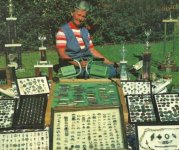I started in 1976-ish, in about 8th grade. But our city had already had some md'rs since several years prior to that (even in the late 1960s). HOWEVER, the only place that any of them and us were hitting, was the obvious school yards. We tended to avoid parks (at least where picnicking and eating and BBQ pits were concerned) because they were extremely junky (foil and tabs), and we didn't have discriminators yet (they were only then starting to be seen in the treasure magazine ads, and there was rumors to avoid them "lest you miss a ring", blah blah).
So we stuck to the elementary school yards in that first year or so that I was into it, since those were cleaner grounds. And the machines we used at the time (77b and 66TR is what my friend and I had) only went perhaps 4" deep. And foil sounded great. No way to disc. it out. They could avoid nails though, but all other conductors sounded the same.
Believe it or not, as virgin as things were, we were doing good just to come in with a merc & some wheaties. And we had utterly no concept of relicky sites in my area . I simply didn't know anyone else who had graduated up to more exotic things. And was limited to where my Schwinn 10-speed bike could take me, haha
When discriminators came out (TR first, then quickly motion disc in '78 to '79-ish), that's when it became child's play to pull silver from parks and schools. But for us, it was just common mercs, roosies, silver washingtons, wheaties, etc.... We didn't have the brains to exploit virgin stage stops and such. I'm sure there were more forward-thinking people around, but I wasn't exposed to them/that early on. The couple of times I did indeed try some local cellar hole/stage stop type site (about 1980 when I got my driver's license and could borrow my folks car) I distinctly recall getting some bullet shells (which , I later now know, were rimfires). And camp lead, etc... And after 15 minutes got bored of "junk" and left. I kick myself now for not realizing that was "good junk". In the late 1990s, now thoroughly hardcore, I went back to that exact same spot and pulled seateds and reales. Doh ! But when I was a kid, I simply had no concept.
And even when our city formed a club in 1980, and I began to meet others, they too were , for the most part, quite tame. Eg.: sandboxes, parks, schools, beach, etc.... A few guys were forward thinking and getting into oldtown demolition sites, stage-stops, etc.... So I began to learn from them.
And if you find others who started in the 1960s to mid 1970s, this is the oft-told story. Only a smaller minority were wise enough to research out virgin defunct carnival sites, defunct scout camp sites, stage stops, CW battle sites, etc...













